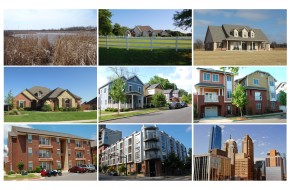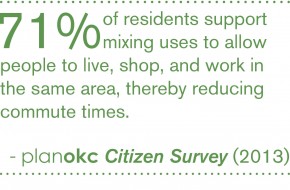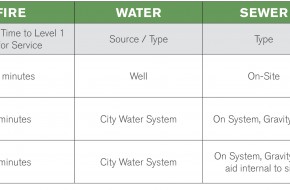Land Use Typology
Base Land Use Typology Areas
The core Land Use Typology Areas (LUTAs) are oriented around a spectrum of development intensities – from undeveloped Open Space, to the high intensity of Downtown. Each encompasses development patterns designed to encourage connectivity and compatibility as appropriate to the intended level of intensity. Base LUTAs are listed below in order of intensity from lowest to highest.
Layer Land Use Typology Areas
“Layer” Typology Areas are content-specific designations that adjust the purpose and function of the base LUTAs. The variations from the base LUTAs differ. Agricultural Preserve, Urban Reserve, and Heavy Industrial narrow the range of land uses or densities to avoid incompatible land use patterns. Regional Districts and Employment Reserve encourage retail and industrial/employment uses in targeted areas, while Urban Commercial and Transit-Oriented districts encourage higher levels of intensity and connectivity.
LUTA Development PoliciesThe Land Use Typology Areas are shown in the Interactive Map and in the map at right. Descriptions of land use policies applicable in each LUTA can be found by clicking on the links below or at left. (Densities shown in the LUTA descriptions are expressed in gross terms unless otherwise indicated. Gross density is the sum of all residential units divided by the entire site area including all common areas, rights-of-way, etc. and is expressed in dwelling units per acre.) |
BASE LUTAs
Open Space (OS)
Concentrations of publicly owned land that are intended to remain undeveloped and natural in character. Certain public uses may be appropriate.
Rural – Low Intensity (RL)
Large-lot residential (5 acres or more) plus related commercial services. No expectation of urbanization or provision of urban infrastructure such as water or sewer.
Rural – Medium Intensity (RM)
Large-lot residential (2 acres or more) plus related commercial services. No expectation of urbanization or provision of water or sewer.
Urban – Low Intensity (UL)
Applicable to the least intensely developed areas of the city that still receive urban water, sewer, police, park, and fire services.
Urban – Medium Intensity (UM)
Medium intensity urbanized area, reflective of the historic urban core, which balances small-and medium-lot housing and commercial districts.
Urban – High Intensity (UH)
Applies to the area surrounding the central business district. Developments are expected to have notably higher densities, scale, and mixture of uses than those found in UM.
Downtown (DT)
The city center, Oklahoma City’s most intense development area, envisioned as a regional center for commerce and tourism.
LAYER LUTAs
Agricultural Preserve (AP)
Preserves large scale acreages used primarily for agricultural purposes as well as large floodplain areas. Existing development patterns are expected to remain unchanged for a long period of time.
Urban – Future (UF)
Reserves agricultural land and large acreage estates until the area is ready for urbanization. Maintains land to provide the most flexibility for future urban development and the ability to efficiently and sustainably deliver services.
Employment (EM)
Reserves priority areas for large industrial and business development essential for the City’s economic stability and future growth.
Urban Commercial (UC)
Encourages the concentration of small-scale retail, office, and service businesses in locations that serve as hubs for neighborhood and city-wide consumer activity.
Regional District (RD)
Designates areas that strategically prioritize the location and concentration of regionally serving retail and entertainment uses.
Transit-Oriented (TO)
Encourages mixed-use development and higher connectivity, density, and intensity, as well as concentrations of commercial activity around areas designated as important future mass transit stops.
Heavy Industrial (HI)
Intended to accommodate industrial uses that are difficult to integrate with less intense uses due to negative impacts from heavy traffic, noise, or odors.

























